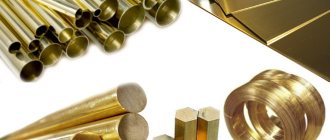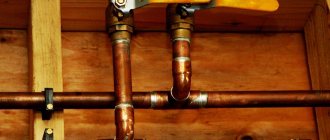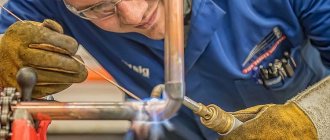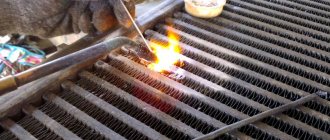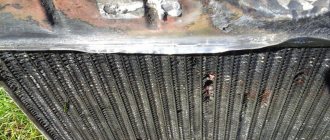Yes, steel and plastic (metal-plastic) pipes account for almost 80% of pipeline communications sales. The rest of the rolled falls on copper pipes . The low popularity of copper communications is due only to their high cost , but otherwise copper pipes are significantly superior to their counterparts made of steel and plastic . This review will tell you how to solder copper pipes.
Professionally installed copper piping has no expiration date. The service life of copper communications is comparable to the service life of the building itself.
Assembly and installation of a copper pipeline can be carried out in several ways:
- Using threaded connections
- Soldering method
If we talk about copper pipes for household communications, then thin-walled pipelines . Such rolled products are ductile and flexible; for this reason, threaded connectors are practically not used for them. To install copper pipelines, it is customary to use soldering. The review will discuss how and with what to solder copper pipes.
Where are copper products used?
Man discovered copper ore more than 5 thousand years ago.
It is not for nothing that the age that followed the Stone Age was called the Copper Age. Since then, the ancients have used metal for many purposes. The next historical stage was called the Bronze Age because at this time they learned to alloy copper with tin and make bronze products. Then brass, cupronickel, and other copper alloys appeared.
The popularity of copper is explained by a combination of physical and chemical properties. Currently, copper is used for the manufacture of pipelines supplying water, gas, and coolants. They make copper wires and radio engineering products.
The advantages of copper pipes are resistance to corrosion and good ductility. Copper products have a smooth surface layer, remain unchanged during prolonged irradiation with UV light, have high thermal conductivity, heat resistance, mechanical reliability, and durability.
Products made from copper are more expensive, but the costs are recouped by the possibility of long-term operation. In some situations, it becomes necessary to solder copper and its alloys.
If there are potential high loads on the joints, the process is carried out at high temperatures. In all other cases, low temperatures are sufficient for soldering a copper pipe.
Technology Features
Fluxes for soldering copper are not always necessary. When carrying out a process with heating to high temperatures, copper fragments can be joined without adding flux mass.
The composition of the solder is of great importance for obtaining a high-quality connection when soldering without flux.
The best option is alloys based on tin and silver, which allow copper to be soldered at high temperatures and get good results.
When low-temperature soldering you have to use solder and flux. Moderate heating is not enough to fully prepare the surface of the parts for joining.
Copper is an unpretentious metal that allows you to work with many compounds:
- solutions;
- finely ground powders;
- gel-like masses.
The components of fluxes have different purposes. Boric or hydrochloric acid, zinc chloride actively react with oxides, removing them. Rosin, wax compounds, and resins provide good adhesion and distribution of solder throughout the work area.
Flux in the form of a paste for soldering copper is popular among craftsmen. It can be easily applied only to the place that will be soldered. It does not spread over the entire part and can be easily removed after finishing work.
Fluxes for gas welding of copper
The main role of fluxes in gas welding of copper is the chemical cleaning of the welded edges from oxide films formed on their surfaces. This happens by dissolving these films and incorporating them into the slag, along with other impurities.
As a rule, fluxes for gas welding of copper are acidic. They contain large quantities of boron oxides. These fluxes have high fluidity and chemical activity.
The main components of such fluxes are borax Na2B4O7 and boric acid H3BO3. In some cases, mainly when the thickness of the metal being welded is small, one borax is used as a flux.
For welding copper sheets of small thickness, fluxes No. 1 and 2 are recommended. Flux No. 6 can be used for any thickness of the metal being welded. To weld thick copper sheets, flux No. 7 is used, replacing potassium carbonate K2CO3 with sodium carbonate Na2CO3. Also, for large welded thicknesses, flux No. 3 is well suited, in this case, replacing sodium chloride NaCl with sodium fluoride NaF, and the resulting weld must be forged.
Flux No. 3 shows good results when welding copper of all grades, using filler wire and without subsequent forging of the welded joint. All fluxes are made in the form of powders or pastes that can be dissolved in water or alcohol.
It is necessary to take into account the following features of copper and its alloys that affect welding technology.
1. Due to high temperature and thermal conductivity, which make local heating difficult, more concentrated heating sources and increased welding modes are required. However, due to the tendency of copper to grow grains when welding multilayer seams, the metal is forged with each pass to refine the grains at temperatures of 550-800 ° C.
2. The easy oxidation of copper at high temperatures leads to clogging of the weld metal with refractory oxides. Cuprous oxide is soluble in liquid metal and to a limited extent in solid metal. With copper, nitrous oxide forms a low-melting eutectic Cu-Cu20 (melting point 1064 0C), which concentrates along grain boundaries and reduces the ductility of copper, which can lead to the formation of hot cracks.
3. The presence of certain impurities may contribute to the tendency of welded joints to form cracks. For example, bismuth, forming a series of oxides, produces a low-melting eutectic with a melting point of 270 0C, and lead, forming oxides, produces a low-melting eutectic with a melting point of 326 0C. For this reason, the content of these impurities must be sharply limited (Bi < 0.002%; Pb < 0.005%), or they must be bound into refractory compounds by introducing elements such as cerium, zirconium into the weld pool, which simultaneously play the role of modifiers.
When welding aluminum bronzes, refractory oxide is easily formed, clogging the weld pool, worsening the fusion of the metal and the properties of the welded joint. To destroy it, fluxes consisting of fluorides and chlorides, alkali and other metals are used.
4. When welding brass, zinc may evaporate (boiling point 907 0C, i.e. lower than the melting point of copper). The resulting zinc oxide is poisonous, so good ventilation is required when welding. Evaporation of zinc can lead to porosity of the weld metal. This complication can be overcome by preheating the metal to a temperature of 200-3000 C and increasing the welding speed, which reduces the spreading of liquid metal and the evaporation of zinc.
A high coefficient of linear expansion (1.5 times greater than that of steel) can cause increased temperature and residual welding stresses and deformations during welding. The combination of high temperature stresses with a decrease in mechanical properties can contribute to the formation of cracks. To reduce the deformation of the structure, welding is carried out in rigid fastening, along tack welds. With increased metal thickness, the gap size is adjusted.
5. Copper in the molten state absorbs significant amounts of hydrogen. When the metal of the weld pool crystallizes at a high speed due to the high thermal conductivity of copper and a sharp decrease in the solubility of hydrogen in the metal, atomic hydrogen does not have time to leave the metal due to desorption. Cuprous oxide is reduced by hydrogen to form water vapor:
Сu 2 O+2Н = 2Сu + Н 20,
which leads to the formation of pores and cracks in the seam.
6. The increased fluidity of molten copper and its alloys (especially bronze) makes welding in vertical and ceiling positions difficult, so welding is most often carried out in the lower position. To form the root of the seam without defects, linings are necessary.
For copper and copper-based alloys, all main fusion welding methods can be used.
Copper is widely used in the manufacture of products for various purposes: vessels, pipelines, electrical distribution devices, chemical equipment, etc. The variety of uses of copper is associated with its special physical properties. Copper has high electrical and thermal conductivity and is resistant to corrosion. The density of copper is 8.93 N/cm3, the melting point is 1083°C, the boiling point is 2360°C. The difficulties in welding copper are due to its physical and chemical properties4. Copper is prone to oxidation with the formation of refractory oxides, absorption of gases by the molten metal, has high thermal conductivity, and a significant coefficient of linear expansion when heated.
The tendency to oxidation necessitates the use of special fluxes during welding that protect the molten metal from oxidation and dissolve the resulting oxides, converting them into slag. High thermal conductivity requires the use of a more powerful flame than when welding steel. The weldability of Cu depends on its purity; the weldability of Cu is especially impaired by the presence of B1, Pb, 3 and Oz in it. The content of rg, depending on the grade of Cu, ranges from 0.02 to 0.15%, III and Pb give copper brittleness and red brittleness. The presence of oxygen in Cu in the form of copper oxide Cu20 causes the formation of brittle layers of metal and cracks that appear in the thermal zone influence. Copper oxide forms a low-melting eutectic with copper, which has a lower melting point. The eutectic settles around the copper grains and thus weakens the bond between the grains. The copper welding process is influenced not only by oxygen dissolved in copper, but also by oxygen absorbed from the atmosphere. In this case, along with copper oxide CuO, copper oxide CuO is formed. When welding, both of these oxides make gas welding difficult and must be removed using flux.
Hydrogen and carbon monoxide also negatively affect the Cu welding process. As a result of their interaction with copper oxide CuO, water vapor and carbon dioxide are formed, which form pores in the weld metal.
The main role of fluxes in gas welding of copper is the chemical cleaning of the welded edges from oxide films formed on their surfaces. This happens by dissolving these films and incorporating them into the slag, along with other impurities.
As a rule, fluxes for gas welding of copper are acidic. They contain large quantities of boron oxides. These fluxes have high fluidity and chemical activity.
The main components of such fluxes are borax Na2B4O7 and boric acid H3BO3. In some cases, mainly when the thickness of the metal being welded is small, one borax is used as a flux.
For welding copper sheets of small thickness, fluxes No. 1 and 2 are recommended. Flux No. 6 can be used for any thickness of the metal being welded. To weld thick copper sheets, flux No. 7 is used, replacing potassium carbonate K2CO3 with sodium carbonate Na2CO3. Also, for large welded thicknesses, flux No. 3 is well suited, in this case, replacing sodium chloride NaCl with sodium fluoride NaF, and the resulting weld must be forged.
Flux No. 3 shows good results when welding copper of all grades, using filler wire and without subsequent forging of the welded joint. All fluxes are made in the form of powders or pastes that can be dissolved in water or alcohol.
It is necessary to take into account the following features of copper and its alloys that affect welding technology.
1. Due to high temperature and thermal conductivity, which make local heating difficult, more concentrated heating sources and increased welding modes are required. However, due to the tendency of copper to grow grains when welding multilayer seams, the metal is forged with each pass to refine the grains at temperatures of 550-800 ° C.
2. The easy oxidation of copper at high temperatures leads to clogging of the weld metal with refractory oxides. Cuprous oxide is soluble in liquid metal and to a limited extent in solid metal. With copper, nitrous oxide forms a low-melting eutectic Cu-Cu20 (melting point 1064 0C), which concentrates along grain boundaries and reduces the ductility of copper, which can lead to the formation of hot cracks.
3. The presence of certain impurities may contribute to the tendency of welded joints to form cracks. For example, bismuth, forming a series of oxides, produces a low-melting eutectic with a melting point of 270 0C, and lead, forming oxides, produces a low-melting eutectic with a melting point of 326 0C. For this reason, the content of these impurities must be sharply limited (Bi < 0.002%; Pb < 0.005%), or they must be bound into refractory compounds by introducing elements such as cerium, zirconium into the weld pool, which simultaneously play the role of modifiers.
When welding aluminum bronzes, refractory oxide is easily formed, clogging the weld pool, worsening the fusion of the metal and the properties of the welded joint. To destroy it, fluxes consisting of fluorides and chlorides, alkali and other metals are used.
4. When welding brass, zinc may evaporate (boiling point 907 0C, i.e. lower than the melting point of copper). The resulting zinc oxide is poisonous, so good ventilation is required when welding. Evaporation of zinc can lead to porosity of the weld metal. This complication can be overcome by preheating the metal to a temperature of 200-3000 C and increasing the welding speed, which reduces the spreading of liquid metal and the evaporation of zinc.
A high coefficient of linear expansion (1.5 times greater than that of steel) can cause increased temperature and residual welding stresses and deformations during welding. The combination of high temperature stresses with a decrease in mechanical properties can contribute to the formation of cracks. To reduce the deformation of the structure, welding is carried out in rigid fastening, along tack welds. With increased metal thickness, the gap size is adjusted.
5. Copper in the molten state absorbs significant amounts of hydrogen. When the metal of the weld pool crystallizes at a high speed due to the high thermal conductivity of copper and a sharp decrease in the solubility of hydrogen in the metal, atomic hydrogen does not have time to leave the metal due to desorption. Cuprous oxide is reduced by hydrogen to form water vapor:
Сu 2 O+2Н = 2Сu + Н 20,
which leads to the formation of pores and cracks in the seam.
6. The increased fluidity of molten copper and its alloys (especially bronze) makes welding in vertical and ceiling positions difficult, so welding is most often carried out in the lower position. To form the root of the seam without defects, linings are necessary.
For copper and copper-based alloys, all main fusion welding methods can be used.
Copper is widely used in the manufacture of products for various purposes: vessels, pipelines, electrical distribution devices, chemical equipment, etc. The variety of uses of copper is associated with its special physical properties. Copper has high electrical and thermal conductivity and is resistant to corrosion. The density of copper is 8.93 N/cm3, the melting point is 1083°C, the boiling point is 2360°C. The difficulties in welding copper are due to its physical and chemical properties4. Copper is prone to oxidation with the formation of refractory oxides, absorption of gases by the molten metal, has high thermal conductivity, and a significant coefficient of linear expansion when heated.
The tendency to oxidation necessitates the use of special fluxes during welding that protect the molten metal from oxidation and dissolve the resulting oxides, converting them into slag. High thermal conductivity requires the use of a more powerful flame than when welding steel. The weldability of Cu depends on its purity; the weldability of Cu is especially impaired by the presence of B1, Pb, 3 and Oz in it. The content of rg, depending on the grade of Cu, ranges from 0.02 to 0.15%, III and Pb give copper brittleness and red brittleness. The presence of oxygen in Cu in the form of copper oxide Cu20 causes the formation of brittle layers of metal and cracks that appear in the thermal zone influence. Copper oxide forms a low-melting eutectic with copper, which has a lower melting point. The eutectic settles around the copper grains and thus weakens the bond between the grains. The copper welding process is influenced not only by oxygen dissolved in copper, but also by oxygen absorbed from the atmosphere. In this case, along with copper oxide CuO, copper oxide CuO is formed. When welding, both of these oxides make gas welding difficult and must be removed using flux.
Hydrogen and carbon monoxide also negatively affect the Cu welding process. As a result of their interaction with copper oxide CuO, water vapor and carbon dioxide are formed, which form pores in the weld metal.
Non-corrosive group
Ordinary light-colored rosin is an inactive flux; it can be easily removed with ethyl alcohol of any degree of purification or technical acetone.
This flux is suitable for soldering copper and copper-based alloys. It is used for soldering wires and radio components.
In areas of recesses that are not very convenient for applying pure rosin flux, you can treat the surface with a solution of rosin in ethyl alcohol.
If copper products are expected to be used under heavy loads, it is necessary to provide a connection with increased strength characteristics. For these purposes, soldering is carried out with a mixture of rosin and glycerin dissolved in alcohol.
Moderately corrosive compounds
Fluxes made from rosin to which alcohol is added with any of the following substances are characterized by low corrosive activity:
- acetic acid,
- zinc chloride,
- orthophosphoric acid.
When soldering, a copper flux made from a solution of rosin in alcohol with the addition of zinc and ammonium chlorides works well. It is effective to use a mixture of glycerin and a solution of zinc, ammonium, and sodium chlorides.
A high-quality connection during soldering is ensured by a flux made from a solution of glycerin in water, to which hydrazine hydrochloride is added. You can successfully use a mixture of alcohol and phosphoric acid solution.
Fluxes containing rosin are used at temperatures up to 300 °C. Other compositions can be heated to 350 °C.
Strongly sour
Compositions containing or forming acid actively remove the oxide layer and have good cleaning properties. However, flux residues after soldering can cause metal damage later. Therefore, the working area must be washed thoroughly at the end of the process.
For soldering copper and its alloys, solutions of zinc chloride in water, zinc and ammonium chlorides in water, and zinc chlorides in hydrochloric acid solution are used. The use of a mixture of zinc, ammonium, and sodium chlorides is effective.
If solders contain a lot of lead and zinc, then it is recommended to use a solution of a mixture of chlorides as fluxes: potassium, zinc, copper, sodium in a solution of hydrochloric acid.
Leaded solders are not suitable for soldering pipes supplying drinking water. Lead is highly toxic; contact with drinking water is not permitted by sanitary standards.
Selecting mode parameters
Welding is carried out on a constant hoc of straight polarity. Welding current (A) is approximately determined by the formula:
Isv=100?S,
where S is the metal thickness, mm
Shielding gases can be argon, helium, nitrogen and mixtures thereof. The arc length in argon and helium should be no more than 3 mm. In nitrogen it is increased to 12 mm. Therefore, the arc voltage and its power increase (3-4 times) compared to welding in argon. In helium, the arc power doubles compared to welding in argon.
Shielding gas consumption:
- argon - 8-10 l/min
- helium -10-20 l/min
- nitrogen - 15-20 l/min
The welding speed is selected from the conditions for forming a seam with the desired geometry. Structures with a thickness of 4-6 mm are welded without preheating in argon, and up to 6-8 mm - in helium and nitrogen. To weld thicker metal, preheating from 200 to 300°C is required.
For soldering with refractory solders
Soldering of copper in certain situations is carried out with solders that melt at high temperatures. Only borax or a mixture of borax and boric acid can be used as a flux in these processes.
A solution of borax and boric acid in water with zinc chloride or a mixture of borax, boric acid and calcium fluoride is also used.
The solders used in this type of soldering are alloys containing copper. To ensure the quality of the connection, the borax must be well calcined before making fluxes yourself. In ready-made products, all components have undergone pre-processing.
Welding technique
Welding in argon with a “forward angle” when releasing the electrode 5-7mm. The following are used as filler wire:
- deoxidized copper
- copper-nickel alloy MNZHKT-5-1-0.2-0.2
- bronze BrKMts 3-1, Br OTs 4-3
- special alloys with effective deoxidizers.
To increase the resistance of the weld metal against hot cracks, welding wires are used:
- BrAZhNMn 8.5-4-5-1.5
- BrMts AZHN 12-8-3-3
- M Mts 40
To prevent molten metal from getting to the end of the W-electrode, the filler wire is not inserted into the arc column, but is fed to the edge of the weld pool and slightly to the side


